A few weeks ago, I took the Teaching Perspectives Inventory, my results of which were used as an example in front of many of my colleagues. My dominant perspective is “nurture”, and I cringed a little, expecting to be chastised for baking cookies for my students (which I do). Instead, Dr Pratt defined “nurture” as placing value on building trusting relationships with students. He asked me if this was true, and I’ve been reflecting on this. Years ago, I was standing in line for coffee in the Barber Learning Centre. Jodi Scott (classroom services) was behind me in line. She said, “Aren’t you teaching right now?” (She knew it was class time because I’d previously asked her for something in my classroom. ) I answered, “Yes, they’re working away in there.” She asked if she could come back to the room with me – she couldn’t believe I’d left 200 students unattended. I do think that I often ask students to do unconventional things, and I think it works because they trust me, and they trust me because I also trust them.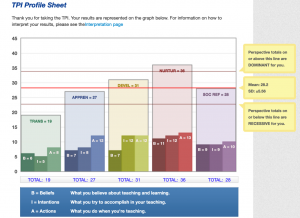
Author Archives: Celeste Leander
Fostering Optimism
Here’s what I’m thinking about today: Sixty percent of Gen Z students are optimistic about their future, as opposed to 89% of Millenials.
How do we foster optimism in our students?
(Source: Levine, A, and Dean, DR (2012) Generation on a Tightrope: A Portrait of Today’s College Student. San Francisco: Wiley.)
Thoughts on teaching (including case studies)
Leander, C., 2018. Questions and Beginning Students. The Teaching Professor, June, 2018.
Leander, C., Kalas, P. , 2017. One Whale or Two or…?, National Center for Case Study
Teaching in Science
Leander, C. 2015. The Last Spruce Grove. National Center for Case Study Teaching in Science.
Dryden, N., Leander, C., Maclean, M., Martinez, D., Waltham, C., Hiroko. 2011. Are We Doing Any Good? A Value-Added Analysis of University of British Columbia’s Science One Program, Canadian Journal for the Scholarship of Teaching and Learning.
Leander, C. and J. Whitton, 2010. Bling my Research! American Biology Teacher, 72: 308-310.
Waltham, C., A. Kotlicki, G. Bates, and C. Leander, 2008. Canada’s National Grade 10 Science Contest: The Michael Smith Science Challenge. Physics Competitions, 10: 16-23.
Leander, C. and R. Huskey, 2008. Those Old Kentucky Blues. National Center for Case Study Teaching in Science. http://www.sciencecases.org/blue_people/blue_people.asp
Research on Labyrinthulomycota, taxonomy and phylogeny
FioRito, R., Leander, C.A. and Leander, B.S. 2016. Characterization of three novel isolates of Labyrinthulomycota associated with sea star wasting syndrome. Marine Biology. 163
Leander, C., D. Porter, and B. Leander. 2004. Comparative morphology and molecular phylogeny of aplanochytrids (Labyrinthulomycota). European Journal of Protistology. 40: 317:328. (Including image on the journal cover).
Leander, C. and D. Porter. 2001. The Labyrinthulomycota is comprised of three distinct lineages. Mycologia. 93: 459-464.
James, T.Y., D. Porter, C. Leander, R. Vilgalys, and J. Longcore. 2000. Molecular phylogenetics of the Chytridiomycota supports the utility of ultrastructural data in chytrid systematics. Canadian Journal of Botany, 78: 1-15.
Leander, C. and D. Porter. 2000. Redefining the genus Aplanochytrium (Phylum Labyrinthulomycota). Mycotaxon 76: 439-444
Annotation, the second most important study habit
In 1988, I started my first semester in college. I entered that first classroom with my new notebooks and highlighters and sat in the very front row. It was a mid-sized lecture hall of maybe 100 students. The professor came in with a big black trash bag. He systematically walked through the class collecting all our highlighters, walked out the back door, and threw them in the trash. He returned and announced, “highlighting is passive and I just saved your asses.”
This was my first lesson from someone who thinks deeply about learning.
In 1998, I began my journey as an educator by working with Dr Michelle Simpson (University of Georgia, division of Academic Enhancement). Our initial question was very simple – “What are undergraduate students doing with their time?”
We began tracking student behavior, by assigning them pagers they carried around for a few weeks. (Which really dates this study…). Every so often (I believe it was 30 minute intervals), the pager would vibrate and the student would record what they were doing in a little book they carried with them. The short not-very-climactic answer to this question is that students spend an inordinate amount of time waiting. (They’re waiting in line for food, waiting for class to start, waiting at the ATM, waiting for a friend to show up, etc, etc.)
These short stints of waiting add up to a big chunk of time during the day, and Michelle had enough experience to know that this was an undiscovered treasure box for students.
She designed a class. It met once a week throughout the term. I taught one section. The entire purpose of this class was to train students to most effectively use these wait times.
Some background: In the 1960s, there was a study done on memory. (I’m anecdotally describing this because I haven’t read the actual study in many years…) In this study, a group of students were exposed to new information in a lecture. (Some sort of humanities, if I remember correctly, although students were from any field). An exam on the lecture information was to take place approximately 6 weeks later. Following the lecture, one half of the students were instructed to study for 1 hr total: this was broken into 2, 30 min chunks. One 30 min chunk 2 days before the exam, and one 30 min chunk night before the exam. The retention in this group averaged around 70%. The other half of the students were also told to study for a total of 1 hr. Except this group studied for 5 minute chunks at regular intervals, starting immediately after the initial lecture. Both groups had a total study time of 1 hr. The second group scored an average of 90% on the same exam.
Summary: The easiest and most effective study strategy is to study in very short chunks. (Note that it is also significant to review new material as soon as possible after lecture. Immediately after if possible.) This simple strategy to more effectively utilize study time results in a 2 letter grade increase, on average. Those 2 hrs you have set aside to study tonight? Research suggests that 8, 15 min sessions spread throughout the day will be much more effective.
OK, this brings us to the second piece. How do you practically utilize 5 min study sessions? (It’s not realistic to haul around your physics book all day…) The course I taught with Michelle Simpson focused on this by training students to annotate.
Here’s how to annotate:
Supplies: some 3×5 notecards, pens/pencils (it’s OK if these are colored), sticky notes, your source material (lecture notes, problems, book.)
Step 1: Read a very small section of your source material. (When you’re learning, this may be as small as a few sentences, but can build to a few paragraphs over time.) Cover it with a sticky note. Ask yourself, “what did I just read?” What was the main idea, plot, or point? Write this on the sticky note. This should be your own summary, and can include abbreviation, a flow chart, etc. (Note: This is an active exercise and replaces highlighting.) Take the sticky note and stick it to a 3×5 card.
Step 2: Repeat with the next small chunk of information.
Step 3: Bring these 3×5 cards with you to utilize wait times throughout the day.
Step 4: Round out your cards by adding problems. You know that math problem you’re stuck on? Write it on a card. Stare at it a few times a day. You’ll be amazed at what your brain is capable of when you’re not paying attention.
Annotation takes time, and this is frustrating. Stick with it!! However, if you’re only going to try one strategy, start with studying in small units of time and save annotation for later.
Finally, I’d like to mention that textbooks used to come with huge wide margins on each page. These were meant for annotation. I still annotate regularly, when I read academic papers. I don’t use sticky notes, but I do make my own summary in the margins. I have not purchased a highlighter in my entire adult life, and I know who to thank for that.
Burning to the ground and starting over (or Transformative teaching during COVID)
When faced with the reality of teaching online we have two choices: (1) try to bend our current pre-pandemic courses and ways of teaching into an online format, or (2) start from scratch and call a do-over.
I chose the latter.
I am not a stranger to tackling learning in new unexpected spaces. My truth is, I enjoy the creative aspect of the brass tacks of course design. What constraints do we have? What are our goals? Where are we going? A few years ago, we lost our large lecture theatre due to renovations on BioSciences. Space was tight, so I finagled teaching a section of our large biology course in one of our residence halls – specifically, downstairs in the ballroom. (This was a feat of creativity supported and crafted by UBC housing, Food Services – who brought us hot chocolate in the evenings, the Centre for Student Involvement and Careers, and the Biology Program – all of whom decided this was a worthwhile effort.) The course ran twice per week at 7PM, and we affectionately called it “the pajama section”.
This summer, when I began thinking about how to transform a course for online teaching, I recognized the process. This was not so different from taking a large lecture course from a big theatre into a ballroom. Here are my top principles to consider:
1. What does this new environment provide that the old one did not? Teaching in a residence ballroom meant a lot of losses. There were no seats, no blackboards or whiteboards, no projection system. But it did have open space that we do not get in lecture theatres. It had open, accessible walls. It had room to dance! And so we did (with pool noodles as chromosomes).
We used the vast space to create things.
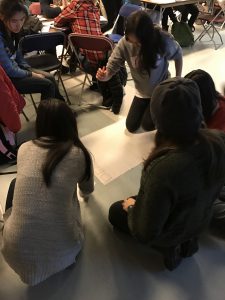
We used the walls as galleries.

We hauled in chairs each week, and students began arriving early to help unfold them. Together we crafted a magical learning space that was different but special. Students learning from home this year have lost a lot of the experience they would have in our face-to-face classrooms. What have they gained? What do they have access to now that they do not have access to in a classroom? The answers here may be particular to a specific course, but the universal principle is the same. (As an example for my course this term (a third year laboratory course), one of the things they gained is temporal – they can do their lab activities at home anytime during the week. They are not constrained to a particular lab section.)
2. Step 1 provides a frame shift towards recognizing that learning from home can be better (in some ways) instead of just adequate. How can this new environment be leveraged in a positive way? This is not unlike the process of flipping a classroom. Start small – maybe with one or two lessons. Creating one amazing thing that students can do at home that they can NOT easily do in a face-to-face classroom can fundamentally shift the attitude towards an online course. (As an example, my students learned about the importance of calibrating an instrument by calibrating their ovens. They document behaviour of birds and/or squirrels out their windows).
3. As I work through the iterative process of “what do they have access to?” and “how can that be leveraged?”, sometimes there are nice places where old curriculum overlaps, and sometimes there is not. Don’t be afraid to let go of the old stuff and do something new. Let’s face it. We are functioning in an emergency teaching situation. We won’t hit all the targets. If something doesn’t transform effectively, get rid of it. Or replace it with something new. One “new” we had in our ballroom was learning about different types of hybrid citrus fruit (from an amazingly small number of wild species), which had nothing to do with anything in our normal curriculum – but it was fun and the students learned something different. Give yourself the opportunity to play and have fun. You will likely stumble onto some teaching tricks or activities that will make your online classrooms even better the next time around.
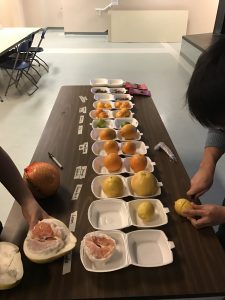
Email Triage
A Tribute to Sky
The photo below is from September 17, 2019, when Sky and I gave a high-5 after our first day at Monarch School. This school is the brainchild of a teacher named Sandra McBrayer, who recognized that youth experiencing homelessness should not be expected to infiltrate into standard school environments. (As a simple and tangible example, where are they meant to store textbooks or do homework?) 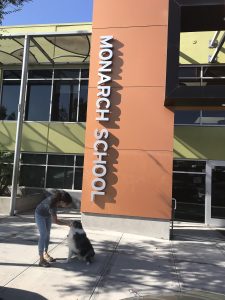
Sky had spent time in the classroom before, at UBC, but this environment was different for her. There was more chaos between classes as kids came and went. The building was big, and she didn’t know anyone but me.
This day was the first day that I truly appreciated Sky’s gift at reading the room. She would calmly sidle up to someone and plop down on the floor. Pretty soon, she’d made a new friend.
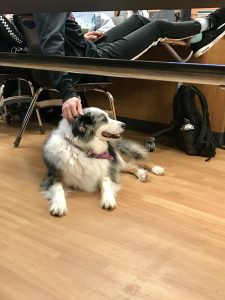
As the year progressed, the depth of Sky’s friend circle grew. Pretty soon, students were asking if they could take Sky on walks around the school (yes.) She was solid, calm, and caring.
In October, a student joined us who didn’t talk to us. He came into the classroom with his hoodie pulled tight over his head. He slumped in his chair. He refused to participate and claimed he didn’t like dogs. He has a personal story worthy of a movie. I watched Sky inch her way closer over the following weeks. Never in his space, but close enough to provide presence. Pretty soon, he began seeking her out and petting her. This particular student became a complete joy within a short period of time – he became an engaged, excited student – and Sky became his sidekick. By the time we dispersed with COVID hit in March, they were fast friends.
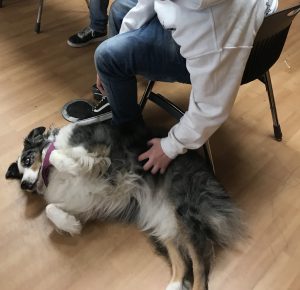
(I want this post to be a tribute to Sky, but the reality of this experience is bigger than our influence. For personal reasons, this particular student did not finish the year with us, and I think of him often. I hope he is safe.)
Sky’s experience at Monarch last year will probably be her last formal work. She’s 10 years old, so happy retirement to the best dog ever.
Pull Up a Chair. (Food and Community Building)
There is an NPR podcast called “Hidden Brain”, where social psychologist Shankar Vedantam describes how eating together increases trust and cooperation.
The truth is, sharing food is a sacred human ritual that traverses time and bridges cultures. It is a ritual that unites us. Food is central to our grieving when we lose a loved one. Food trains have emerged as a way to shore up families with new babies. We share food as a celebratory event, or to simply establish friendships. Sharing food “increases trust and cooperation”.
It turns out that first year students are doing a lot of becoming. According to Upcraft et al, developing academic competence is just a small part of what transition to university or college entails. Young folks are also exploring identity, thinking about careers, exploring faith, and developing civic responsibility, among other pursuits that are fundamentally important to this process. An important one is learning to establish and maintain relationships.
I have long invited (lured) students to come to office hours with the promise of food. Not only does this “increase trust and cooperation”, but it gives students an easy excuse to show up without fanfare or premeditated questions. Just to show up, because they were invited to pull up a chair.
I’ve continued this tradition in our Collegia where I often show up with ingredients and spontaneously invite students to bake with me. The conversations we have while distracted with food are easy and important. When I teach a small 3rd year course in Human Ecology, we create a food calendar and share and learn about foods that are important to each of us. This small act really does increase trust and cooperation in this group.
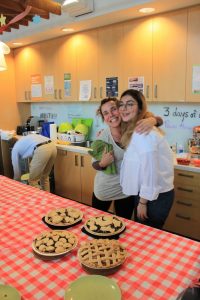
I will leave this post with a recipe from my grandmother, who grew up on a Mennonite farm in the 1930s. I invite you to pull up a virtual chair.
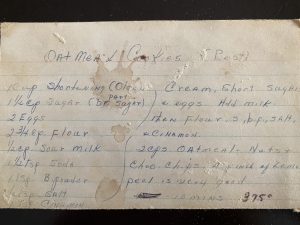
The In-Between Times (A before lesson plan)
My good friend and colleague, Natalie Gerum over at the Centre for Student Involvement and Careers, is one of the most creative and careful educators I know. When it became clear that we would be teaching online this term, my single first thought was – “How do we build meaningful community in an online forum?”
Natalie is an expert community builder, and we both recognize the (well documented) importance of strong and early relationship building to the academic success of first year students. (For more on this, I suggest a book called “Challenging and Supporting the First Year Student” by Betsy Barefoot, M. Lee Upcraft, and John N. Gardner). (Full disclosure: I’m not actually teaching first year students this year, but I’ve taught first year for decades, and I think first year principles are so ingrained in my teaching that they are there to stay.) So I called Natalie.
In relationship building for education, one of the critically important but often overlooked pieces is what Natalie calls “the in between times”. These are those unscripted times when students walk into a classroom and sit down next to someone. They look around. They roll their eyes when the professor is late. They chat with the person sitting next to them. I whined, “How am I going to do this in Zoom?” And Natalie said… “well, you start your Zoom class. Let the students join, and disappear. Maybe show up 5 minutes late.”
(See? She’s a genius.)
And so I began my term by opening up my Zoom lectures 15 minutes early and I post a PowerPoint slide of something to do. Sometimes it’s colouring (via Zoom annotation), or origami instructions, or a crossword puzzle. I share my computer music and play my extensive collection of 70s songs (so they really have something to talk about). And then I walk away and make coffee. When I come back 20 minutes later, community has happened. They’ve shared recipes on the chat forum. They’ve started a discussion group (without me). They’ve made friends.
Which just goes to support my tried and true teaching truth: sometimes the most important things we can do as educators is get out of their way. (More on this later…)

